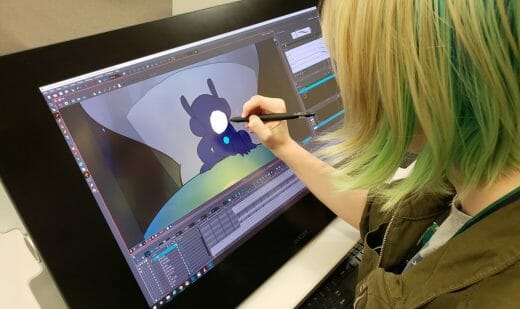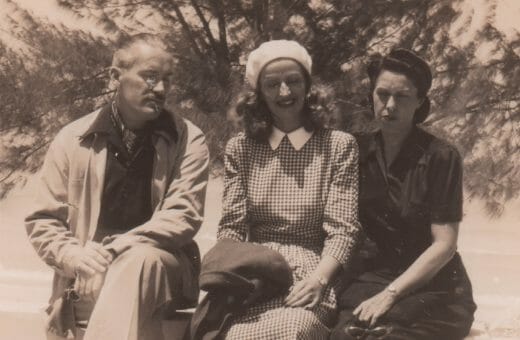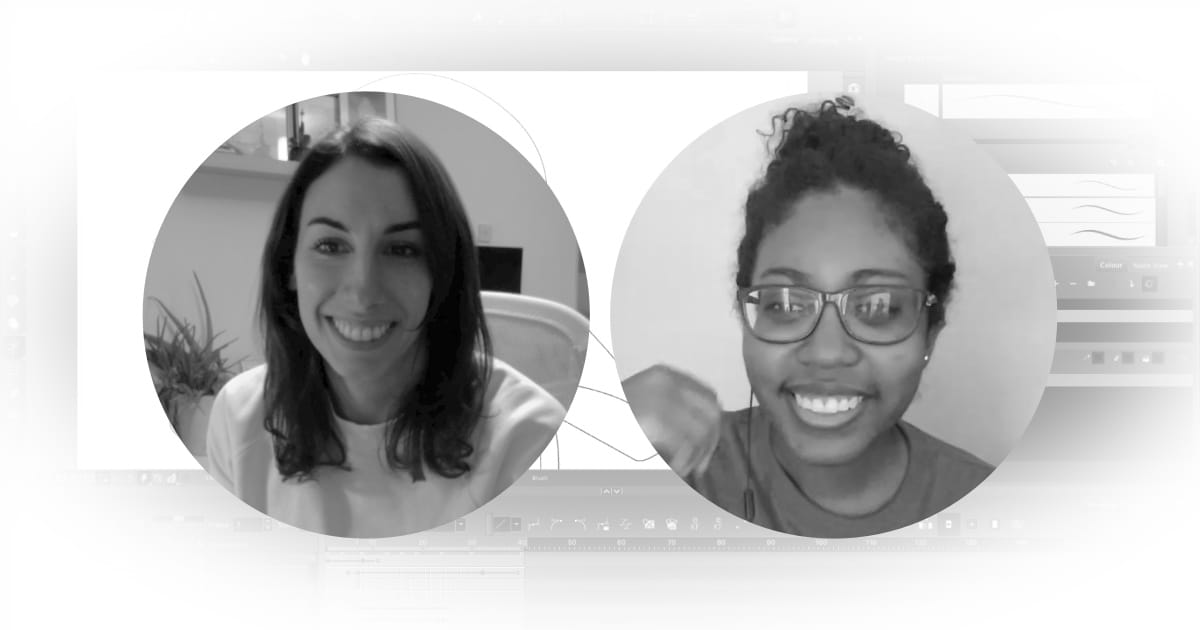
ScreenCraft Works is an international program based out of the U.K. that pairs up underrepresented production and post-production talent working in film and television with seasoned industry professionals interested in mentoring. ScreenCraft Works also hosts talks and networking events with the goal of creating a more inclusive, diverse, and connected industry. After speaking with ScreenCraft Works co-director Elizabeth McIntyre, we had the opportunity to speak with Setareh “Seti” Erfan and Tajha Winkle, a mentor-mentee animation duo in the Cross-Border Mentoring program who have been supported with free Toon Boom Harmony licences.
Setareh Erfan is an animator and illustrator based out of London, U.K. She has worked on projects as varied as Love, Death & Robots, Cheeseheads, and Gorillaz’s Song Machine series for YouTube. Her most notable project has been The Boy, The Mole, The Fox and the Horse, which won the 2023 Academy Award for Best Animated Short Film.
Tajha Winkle is an animator and illustrator living and working in Jamaica. Her student film, Carpe Diem, was an Official Selection at the Animae Caribe International Animation and Digital Media Festival (2021), and an Official Selection at the Conch Shell International Film Festival (2022). Her work post-graduation has been featured on Sesame Street, and she is the animator behind the animated intro and outro to Saeed Thomas’s Black Girl in the Ring, a short film about Jamaican national hero Nanny of the Maroons.
We discussed the benefits of cross-border mentorship, the realities of post-pandemic professional life, and ways that the international animation community can support up-and-coming animators in the Caribbean.
What got you into animating and illustrating, and what has your career path looked like up to this point?
Tahja: I’m Tajha Winkle. I started illustrating when I was in college as a freelancer. And I actually did my bachelor’s degree in animation, so there’s been a love there and a passion ever since.
I had started freelancing initially, almost falling into it by coincidence. Someone had messaged me on Instagram saying that they wanted a children’s book illustrated. And I wasn’t so sure at the time if I wanted to do that or not, but I still said yes anyway.
From that, I just kept going and falling in love with it. And here I am, four or five years later, still doing it, still loving it. In between that, I’ve been working on my animation portfolio and freelancing on local films and international projects as well.
I had done some stuff for Sesame Street in 2022, which was really awesome and exciting. So I’m really hoping to go up from there.
I noticed that a lot of your illustration work seems to be children’s books, which is delightful, and you just mentioned Sesame Street. Do you focus more on producing children’s media or is that just something that has presented more opportunities?
Tajha: I really do love children’s animation. Even now as an adult, I find myself always going back to those children’s cartoons. There’s something so beautiful about them and the stories that they tell that I really love, and the colours, and just how lively they are.
How about you, Seti? What brought you into animation?
Setarah: From a young age, I always knew I was going to get into something involved with drawing. That’s a passion I’ve had from a really young age. It was sort of a straight course to study animation at university. I did an undergraduate, then I did a post-graduate. And the post-graduate is what opened the doors for me to eventually get into the industry in London. Initially I had to do internships, or I had to work for free or whatever.
I think at the time I got into the industry, 2D wasn’t where it is now. It’s definitely exploded. It’s really good now. There’s loads of opportunities, there’s loads of programs for people trying to get in.
So it was really difficult [at first]. But through time, and getting the right connections, and then getting my foot in the door at a few studios in London, it went from there. I had the opportunity to work on really great projects with amazing people – short films, music videos, commercials. London had a really big commercial industry. I think they do a lot of game trailers now.
Through all the different jobs that I’ve done, I’ve always tried to push myself. I started coming through cleanup and assist, and now I’m trying to push more to be seen as an animator, doing rough animation. But I’ve done cleanup supervisions as well. The most prominent thing was being the clean animation supervisor on The Boy, the Mole, the Fox and the Horse. That was wonderful.
I’ve worked on another short since then as an animator: Peter and the Wolf. And then music videos, like Gorillaz’s music videos, and a few game trailers, working for different studios around London. It definitely was a journey, and it took some time and a lot of patience. But it’s been a very rewarding journey.
And here I am now. I think it might have been the connection with The Boy, the Mole, the Fox and the Horse that prompted Rebecca del Tufo and Elizabeth McIntyre to get in contact with me. They said they were doing this mentoring program, and would I want to mentor someone? I said, “Sure!”
I feel like a lot of people have given to me when I’ve been learning and progressing. And I thought it was only fair that I give back as well.
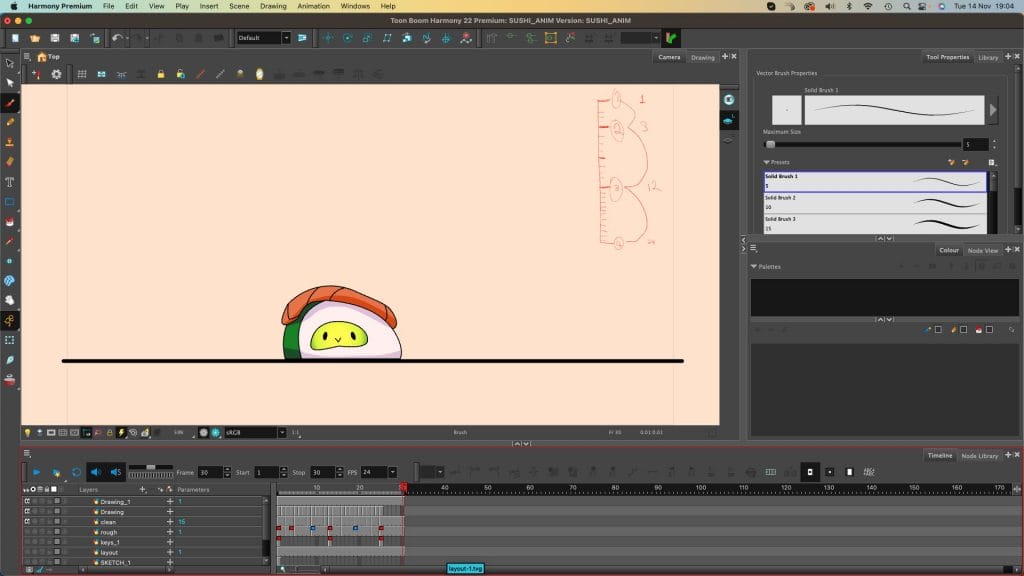
Is there a particular kind of project or animation style that you gravitate towards, or do you really enjoy the challenge of switching between styles and formats?
Setarah: I’m open to lots of things. It’s a lot of fun to animate really bouncy, cartoony characters. You can have a lot of fun with it. But then at the same time, I really do enjoy trying to animate very naturalistic, human-looking characters by really delving into subtleties.
It’s good to be open. You have to adjust to different styles for different projects. It can be fun to do those two different extremes.
How did you each hear about ScreenCraft Works, and what initially interested you about the program?
Tajha: I follow an organization called Women in Film and Television – their Jamaican branch. They had posted an opportunity on Instagram that ScreenCraft Works was having a mentorship program. So I checked it out and I was saying, “This looks like it could be something for me.”
They had this awesome checklist, which I really loved, which is what drew me to applying, of what you specifically wanted to look for. It was a very thorough checklist, and it had some soft skills and some hard skills that you’d want to learn. I just went through and I ticked off so many of them. So I was like, “Hopefully they can find someone for me.”
For a little bit, I didn’t hear back. And then eventually, Elizabeth emailed me again and Rebecca emailed me and said, “Hey, we’re still looking for somebody. We want to make sure this person’s a good fit.” And that is what kept me hopeful, and what kept drawing me in.
Eventually, they found Seti, and they said, “We found this person. We think she’d be really awesome and a great fit for you. Just let me know what you think.” And it’s been a really great journey so far because of that.
I’m really glad that I came across that on my Instagram feed. I love following those film and TV Instagram pages for that exact reason. I couldn’t have asked for a better mentorship program, honestly.
Setareh: For me, it was Rebecca that got in touch. It was after the success of The Boy, the Mole, the Fox and the Horse. She reached out and said that they were looking to partner up people in the industry with people trying to break in.
I was very happy to do it. I’d done a bit of mentoring in the university where I did my post-graduate course. They did have a mentoring scheme that they would do every year, and I had been mentored myself.
And in the industry, there are people that I’ve gotten to know that have been really supportive throughout my time. I owe a lot to them in terms of how I’ve developed, and I think if you can have that person as a mentor, it just helps so much.
I know the value of that and it’s nice to be able to give back and help Tajha as well. Hopefully, Tajha, you’re enjoying the experience, but I already see how much you’re progressing.
How long have the two of you been paired up?
Tajha: Since April. Since spring.

Seti, the main project of yours I had heard about was The Boy, the Mole, the Fox, and the Horse. What was it like to work on a project that received so much attention?
Setareh: It was a really great experience. When I went onto it, I didn’t realize how much of a following the book had had. But I worked with people I had worked with before on other projects, but it was really nice to be more involved in supervising.
It was definitely very challenging. It was all done remotely, and the crew at one point got very large – particularly the clean animation department. And it got so big because there was just so much work to get through.
What we had to do in terms of 2D animation was an incredible amount of work. We worked very closely with Charlie Mackesy, who’s the author of the book, just to make sure that his style was reflected as closely as possible in the film while making it doable for the animators and the clean-up artists and the inkers.
So it was challenging. But just to see how it all came together and all the hard work everyone put into it was amazing. To see the success that it had, it was incredible to know that we were a part of that.
I often find that, with the most challenging projects, you create the best bonds with people. Those projects are always intense, but you come out really proud of being part of something really special. And you gain greater friendships from it as well.
In a freelance career, those friendships are everything. When you’re not working shoulder-to-shoulder with people every day, making new contacts is so important.
Setareh: Yeah. We were all remote as well. It was during the pandemic. I had been in the industry for a few years so I already had the connections. But there were a lot of people in the crew that maybe were new to the industry. It might have been their first freelance gig.
Obviously, trying to find work at that time was just even harder, because everyone was remote. You couldn’t go into a studio. You couldn’t meet people. And you couldn’t be sat next to someone who could guide you through it.
So obviously that was difficult, but this was an amazing opportunity for those people. I know those people made connections and have gone on to further projects. Because that’s what it is – you just need to get onto a job, or get into a couple of studios, and that’s it. You’re on the books. It just builds from there, really.
Tajha, the project of yours that Elizabeth McIntyre spoke about so highly, and I heard has received a lot of attention, is Black Girl in the Ring. I was wondering if you could talk a bit about that project and maybe what doors that project opened for you?
Tajha: Sure. I was pitched the project by a live-action film director out here named Saeed Thomas. We had met earlier through Twitter. He had seen my work and thought it was really cool. So we spoke for a bit, just discussing work, and he owned a production company out here. He said he wanted to, as we say in Jamaica, set the link, so that we would always have each other’s contact information. So he reached out to me with this project and he said it was based off of a national hero here in Jamaica called Nanny of the Maroons.
It was a story about her being young and a symbol of liberation for her people as they fled the horrors of slavery to go live in the mountains. I loved that concept. And he said, even though it’s a live-action film, he wanted an animated intro and an animated outro. So I said, “Alright, cool.” This was entirely self-funded at the moment with him. It was an indie project. So we had to work around the narrower budget. We ended up going back and forth about what we could do and we settled on a semi-movement, comic style, where it wouldn’t be completely animated but you would still see some moving parts.
I thought that was really cool and I delved into it. I’d say this is the biggest solo project that I had to take on. It was the first time that I was working on something of this nature. I was very nervous. I ended up even having to get my first subscription to one of those really big storage sites so I could send one file. They were like 2GB – they were so heavy. It was super exciting. I ended up learning a lot. It was a lot of trial and error as well, because sometimes I would export a file and something would come out blurry, and I’d have to troubleshoot. I ended up having to learn so many different types of software just to get this out.
I loved how the end result came out. And he loved it so much that we were actually discussing the other day how it would be cool if we could make this whole thing animated. It just came out so well. It would be really awesome if that ended up happening.
The story itself really is so important. I wanted to capture how intense of a story it is with the colours and the animation, but also just how approachable it is as well. I feel like that’s how animation is – it can make stories like this feel so approachable for people. And I think that’s really important, especially when stories like this can be a bit heavy for a general audience. So that’s really what I aimed to do.
This all happened before I got into the mentorship program. And now looking back at the work, of course, looking at it with fresh eyes, you’re like, “Ooh, I can tweak this and tweak that.” So if it was ever to go fully animated, it would be amazing, with the current skills I have now, to assemble a team and do something great with it. It was a really great learning experience. It’s on the festival circuit right now, so that’s why it’s not available online anywhere yet. But once it is, you’ll definitely see me posting it everywhere saying, “Go check this out!” I love how it turned out. It’s fantastic.
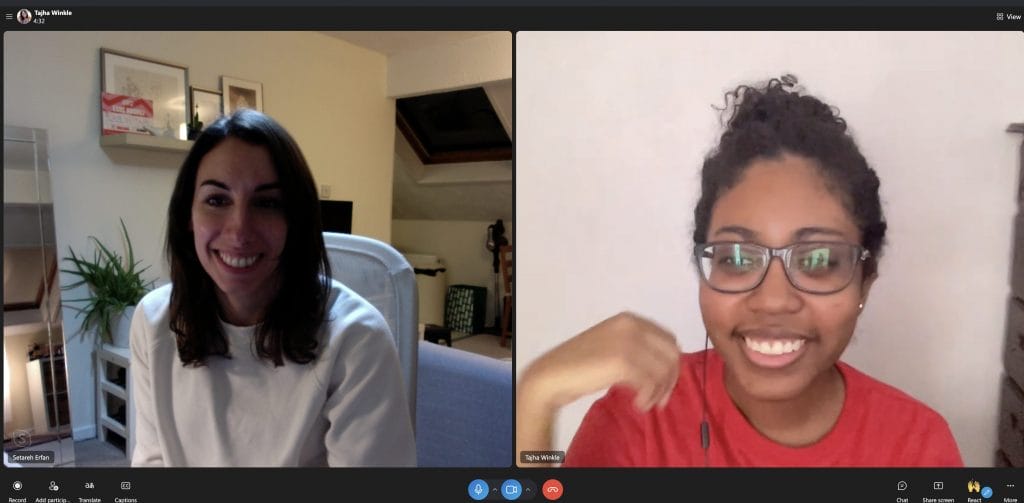
It covers an such important figure in Jamaican history that, internationally, we aren’t taught enough about.
Tajha: It’s pretty much the solid basis of all of our history classes here. So it’s really a very important film. I do think more people need to know about it because it’s a story that really captures that feeling of freedom and the struggle for emancipation.
This happened in the 1500s – so, so, long ago. And slavery didn’t end until the 1800s. So it really embodies this long fight for emancipation that happened here in the Caribbean.
This was a wholly Jamaican production. Do most of your projects come from international opportunities, or do most of your projects come from Jamaica?
Tajha: So far, I’d say it’s been a mix of both. I’ve gotten the opportunity to work on two local productions: one of them a movie and one of them a pilot. I’ve also gotten to work on one international production, which was the Sesame Workshop animated short. That one was about the number eight and it featured some manatees that were swimming around. We even got music commissioned for that, because it was supposed to be Caribbean-focused.
In terms of the picture book realm with the illustrations, I do get most of my commissions from abroad. And a lot of it does come from the Jamaican diaspora. They’ll reach out to me from China, or they’ll be in Canada, or they’ll be in the U.S., and they’ll say. “Hey, I have this awesome book idea that I want you to illustrate. Right now I have an agent, which is super awesome. She’s based out in Florida, so hopefully I get to work with traditional publishers in the future as well. That’s one of my major career goals.
You’re both currently freelancers. Is this a career path that you chose intentionally for its benefits, or was this simply a choice of practicality?
Setareh: When I got into the industry, and when I studied, it was a case of, “Okay, now you graduated, you’ve got to set yourself up as a freelancer.” That was the best option for where I was.
More opportunities were coming from studios that would hire freelancers so that seemed like the way to go. That’s just the way the industry is set up. There are full time opportunities that crop up sometimes. But during the length of time I’ve been in the industry, I’ve only had one offer for a full time position. And I actually turned it down because I felt freelancing was the best way to go. It just gives you that flexibility to work on different projects and meet different people, but also to grow and have different experiences and opportunities.
Now, because of the pandemic, remote working is a lot easier. I have been able to work for international studios. That was really great. I had to be a freelancer, in a way. That was the route. But at the same time, there are so many benefits to it.
Tajha: I’d say I’m similar too. The animation industry in Jamaica is still pretty small. There’s a small handful of major studios in Jamaica and probably about ten major studios across the whole Caribbean. So, not a whole lot of options.
I ended up knowing, even before I graduated, that I would have to freelance to make a living as an animator. But eventually, I do really want to work at a studio. I know that, with the way the industry is going, full time jobs are disappearing at studios, unfortunately. But I would really like to work in a studio.
I think that kind of environment is great when you’re a junior. Because right now, I’d be a junior coming up. I’d love to get that hands-on feedback in that environment, and to physically watch people work and do their craft. That’s something I’m missing, working here in my bedroom. That’s one of my career goals: to work in a studio.
Based on your experiences in the U.K. and Jamaica, what could the industry be doing more of to encourage the voices of those who aren’t heard often enough?
Tajha: Speaking as a Jamaican, our voices, especially in the Caribbean, are not usually represented in media a lot. And when we are, it’s usually as comedic relief. That’s not great for our self-esteem, I would say.
So in a lot of the media that we make, we feel a bit pressured to do comedic relief as ourselves. It’s almost like we make a caricature of ourselves in media to show the world, because that’s all they’re receptive to. It would be really great if we were able to grow beyond that, and for major studios and even indie studios that want to take on that kind of content – to allow us to not just be caricatures of all Jamaican people, but to be our authentic selves.
A lot of the films out here focus on that. A lot of great stuff is coming out, especially in the animation scene. But unfortunately, a lot of the things that do get popular tend to be more on the caricature side. It would be really great if we could push the voices of the Jamaican people and the Caribbean people as a whole.
Something else I’m really passionate about is integration with education. There are not a whole lot of studios in the Caribbean, or in Jamaica. It would be really great if we could get schools internationally to partner up with major universities that offer art programs within the Caribbean, so that we can have that exchange of knowledge and help build a more solid arts foundation. To help make students feel more empowered to compete is this international industry, and to help build up the building blocks so the art industry can get stronger here locally. Those are some of the things I would really love to see.
Setareh: From a London, U.K. perspective, I think a lot of steps have been taken to improve and change. I’ve definitely seen a change particularly in the last two, three years. There is a drive for greater representation. I’ve seen a lot more women directors coming to the fore. People of different backgrounds, minorities, are being represented. Definitely I’ve seen a change. So I think the U.K. has definitely taken strides forward, so that’s really great.
Even on projects that I’ve worked on, the characters’ designs have definitely changed. It’s more of a mixed representation. I can’t say much about what I’m working on right now, but already the characters we’re working with are more diverse. So I think it’s changed a lot, in a positive way.
Coming from a female perspective, something I found initially in the industry was that you didn’t see many female animators. A lot of women would tend to be in the clean-up or colour departments. For me, that’s been the greatest challenge in my career: being recognized as an animator. As much as I enjoy clean-up and assist, I always wanted to show that I could do more. In the last few years, I’ve definitely had more opportunities come my way.
I don’t know if it’s the impact of social media as well, but I’ve definitely seen a lot more organizations that have been set up to either support women, or ethnic minorities, or whoever, and programs to help people get noticed.
As members of Screencraft Works, you’re supported by Toon Boom with Harmony licences. Has that been helpful? And what has been your experience with Harmony as an animation software?
Tajha: It has been extremely helpful. In Jamaica, our dollar is super weak, so having access to Harmony was something that I thought could only come through a studio. I had access to it when I was going to university, but after that, I lost access. So it was really good to have access to it again and to get back into it, and learn all the new features that came about during that time.
The software I was using before didn’t have a scrubbing feature, so Seti can tell you I was struggling with the lip sync because I couldn’t scrub the audio to get it right. We were going back and forth. I even had to pop it into a different software to try to splice it to get the audio in. But then with Toon Boom Harmony, I redid the whole thing. I could scrub the audio, and it got it really great. It really improved my workflow a whole lot, and I can really see how much I’ve improved.
I feel like it’s also helped in terms of broadening my job prospects. Over here on this side of the world, we use Toon Boom a lot more, especially with the studios and those different productions. Harmony is the primary software that they use, so having access to it and up-to-date knowledge of it as well really puts me in a much better spot than I was in previously. It’s been instrumental.
Right now, I’m finishing up the Harmony Fundamentals course. I’ve been showing Seti the stuff that I’ve been doing in it. I’ve been learning, and every time I learn something new, I’m like, “Oh my gosh! This is so cool! This makes that so much easier!”
It’s been such a big help, so I’m just so grateful for it.
Setareh: When I heard that ScreenCraft Works had partnered up with you guys, first and foremost I was just so happy that Tajha had access to professional, industry-standard software. And then Elizabeth said that the offer was extended to me as well, which is absolutely amazing. I predominantly work in TVPaint, and that’s how the London animation industry has been working with. But I have started to see more projects being set up in Toon Boom Harmony. So this opportunity for me to have access to Harmony is going to help me as well.
I’ve done a couple of jobs with Harmony, but there’s so much about Harmony that I still don’t know. So this is an incredible opportunity for me. And the fact that we both got access to these licences will allow us to share working files. What’s been happening at the moment is that Tajha will do an export, and then I would look at it and sometimes I would, say, import it into TVPaint and scrub through. But if we’re both using Harmony, then we can share the working files straight in.
And if Tajha needed any feedback or suggestions, I could do it straight in the software. To have that available to us is amazing. This just opened another door.
- To learn more about ScreenCraft Works, check out the organization’s website here. To apply to become a mentor or mentee, fill out an application form.
- Setareh Erfan can be found on Instagram, LinkedIn, and on her website. Check out her showreel here.
- Check out Tajha Winkle’s online portfolio here, or set the link with her on X, LinkedIn, Instagram, or Bluesky.


